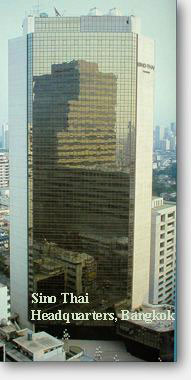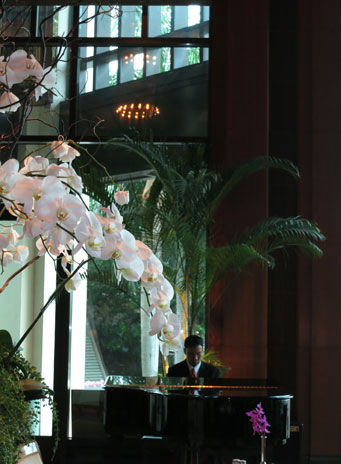STPI, a dash to LNG gas play
STPI (28.50) is one of my 3 select engineering Thai companies into next year. 
As I explain in recent months I currently favor select Thai engineering companies in different but specialized growing fields. Consider STPI, PYLON DEMCO, (PYLON after taking profits in early '12, and now back on this correction) all have this feature in common. (CITY comes close to that as well as does TRC, another such engineering company should be good too but I sort of lost a bit of interest there some time ago due to previous disappointments). I still like DEMCO as the best despite its near 60% price appreciation year to date. Because we cannot count on SET rationality -and for diversification purposes- it is always obviously more prudent to invest more then in just one company.
I visited in person STPI (28.50) last week and I can see how revenues and earnings will jump again in the second half this year and far more so next and then even more so in 2014. I think STPI is very interesting because of its recent good experience in the LNG terminal industry. Here we have seen a global and regional boom of late and more to go. STPI is more exposed to the vibrant AUSSI energy sector (Modules) and global “dash to gas” trends, vs. PYLON and DEMCO are pure domestic plays. The three together are the good mix.
To me it is clear that LNG gas is in a strong uptrend -at least for then next few years. Call it a global trend of “dash to gas”. Gas is a far less polluting carbon energy source and there is plenty being discovered due to new technologies, with the US leading on this front. There are a some shrewd US money managers which have advocated taking advantage of this uptrend by investing in large LNG ships which transport this liquid gas. I instead, would much chose Thailand’s STPI as the pure play on this boom in progress.
Moving towards cleaner fuels is boosting LNG demand especially in the emerging economies in Asia, particularly India and China and Australia. According to Woodside Petroleum—Australia’s largest oil & gas company—demand could top 10% per year up to 2025. In addition the Oxford Institute for Energy has reported that Japan's annual LNG demand is estimated to reach 88.7 mn metric tons in 2020, up from just 36.8mn in FY10, that is if the nuclear power is not restarted. LNG consumption has grown since the Fukushima disaster in Mar-11.
The anticipated growth in demand is the key impetus to expand the Pluto site and develop the Browse & Sunrise LNG projects as well. I would expect STPI can pick up some contracts in the future from Woodside. But the exciting story with STPI is their mega already awarded 739 mill US$ Ichthys project.
Description: STPI—with a steel fabrication capacity of 60,000 tpy & module assembly yard of 30,000 tpy.—is one of Thailand’s biggest piping fabricators. All its facilities are located near Thailand’s major Seaport Laem Chabang & Map Ta Phut Seaport and a big harbor in Sriracha. STPI can fabricate large built-up beam steel for huge infrastructure and heavy industry projects, such as power plants, oil refineries, petrochemical plants, high-rise buildings, roof structures, bridges, elevated highways and airports. STPI was listed in May 1992. Charnvirakul family owns some 13% of the shares outstanding. This company has a market cap. of around 330 mill US$ or based on that, is about 3.3 times bigger then DEMCO. STPI is very much a company which has an uneven flow of revenues and earnings due to the nature of its business. But into next year and the following the earnings uptrend/explosion is coming again. The 52-week high/low of their stocks price Bt36.50/Bt17.80 respectively.
This has longer term potential
Inpex—is now an STPI’s client: Inpex Corp of Japan, a leading O&G exploration & production company, has more than 70 projects in 26 different countries. The development of the Ichthys gas & condensate field in Australia is deemed as one of the most challenging one just as it is one of the largest with 12.8 tcf (trillion cubic feet) of gas and 527mn barrels of high value condensate in reserves. (Ref: http://www.inpex.com.)
There so is strong demand potential for built-up beam steel: Rising LNG demand across Asia drives new investments not only for specialised ships and production facilities but in logistics as well. There are several terminals within the region currently under construction with Singapore (80% complete) visibly moving towards becoming a regional LNG trading hub, just as it is in oil trading now is. Other potential LNG terminals’ sites include Indonesia, Malaysia & Thailand. Vietnam’s first LNG import terminal is also expected to be completed by 2015. Having terminals facilitate cargo flow and could render field developments viable. This is constructive to STPI’s future earnings growth outlook for this means demand for large built-up beam steel fabrications.
Any new Thai Competitor is kept out due to logistics.
Deep water port – key barrier to entry: In Thailand any potential competitor can be kept out of the market by pure logistics. STPI has a long term contract up to year 2020 for a site in the Laem Chabang Deep Seaport that is operated by the Port Authority of Thailand (PAT). The contract includes 191 rai of land that is BOI grandfathered. This is their location for module assembly. The deep seaport there facilitates the delivery of the completed modules upon completion. Other players could come and replicate STPI with module facility located inland and the rent a dock from PAT when it is time to move the module. But this is very costly and could create delays and possibly damage to the delicate structures. So there are significant logistical barriers to entry.
Here are some noted from STP&I latest Annual Report, 2011.
The economic downturn in 2010 and 2011 has impacted STP&I Public Company Limited in term of the delay in large-scale project investment which caused an interrupted workload in 2011. Thus, in addition to "lessons learned" in efficiency improvement of project management and work process which has been emphasized in the past years, this year the Company gives importance to marketing and business continuity management by keeping up to date with information and customer position to analyze and plan preventions and corrections to mitigate such risk and also prepare for Oil and Gas business expansion in the next decade.
With efforts and commitments of their marketing and operation team together with a constant growth in energy industry, especially in Australia (their major market) “STPI is fully confident that 2012 shall be the beginning of successful future”. The Company was awarded a very large 739 mill US$ project in February this year.
“For the year 2012, the Company maintains the strategy in having Australia as its major market as the economy and construction industry in Australia will continue to boom for at least 5 years especially for the mega projects in Energy sector. Japan and in Middle East countries economy, our secondary market, are stable and slightly slow down and the project size is likely to be small to medium size.”
STP&I is the leader in exporting fabricated steel structure to customers worldwide. The Company received BOI privilege which allows STP&I the benefits of corporate tax exemption. STP&I also gets exemptions on VAT and Import Duty on imported material. These privileges have contributed to the competitive advantages for STP&I to effectively compete with other steel fabricators within this region.
Fluctuations of raw material costs are likely to STPI's advantage this year.
Raw materials used by STP&I consist of steel section, sheet metals and pipe which are still affected by the risks of market price fluctuations in year 2012. Realizing this, the Company has thus proposed some of its customers to source their own raw materials. This has proven mutually beneficial to both customers and STP&I where in 2011, customers who provided their own materials accounted for 90% towards the total company’s revenue.
In year 2010 and 2011, STP&I purchased its own raw materials, namely, steel section which accounted for 1% and 1.3% of its total cost of sales, respectively. The purchase of these steel sections were made directly from local suppliers which accounted for 100% of raw materials purchased by the Company in the past 2 years. Additionally, the Company also purchased steel plate raw materials from suppliers in 2010 and 2011 which accounted for 2% and 0.5% of its total cost of sales, respectively. The purchase of such steel plates were made directly from local suppliers which accounted for 60% in 2010. In 2011 the Company purchased all steel plate from local suppliers.
Foreign exchange rate fluctuations are closely monitored by the Company. To avoid such risks, the Company has negotiated with the clients to settle in a Thai Baht Contract from 2008 onwards. However their next huge project is payable in US$ and the company has hedged half this currency exposure. This year the US$ has slightly appreciated vs. the Thai Baht. The company has no exposure to the AUSSI $.
One of STP&I’s strengths is its capability to fabricate large built-up beam steel for huge infrastructure and heavy industry projects such as power plants, refineries, high-rise buildings, roof structures, bridges, elevated highways, and airports. STP&I owns and operates four production plants include steel structure fabrication plants in Chonburi and Rayong, Piping fabrication shop in Sriracha and Assembly yard at Laem Chabang Port. With a total capacity of 115,000 ton / year, STP&I has used its capacity at 50 % in year 2010 and 2011.
Core Business of STP&I can be categorized into three key groups:
Engineering Service: The Company provides engineering service in detail design of steel-to-steel connection, shop drawing for steel structure, piping, and erection works by various specialized software.
Fabrication: The Company provides fabrication service and has the capability to fabricate steel and pipe in workshop which equipped with state of the art machine and equipment, CNC.
Cutting and Welding machine, Press machine, automatic Blasting machine and other tools necessary to undertake the variety and complexity of fabricated products to ensure the efficiency of fabrication processes and cost effective.
Construction: STP&I’s construction works include assembly, mechanical equipment installation and erection for various manufacturing plants. The Company performs the works both at the Company’s facilities and at the client’s project site.
The company products can be categorized into 4 groups.:
Steel Structure Fabrication
Steel structures for heavy industrial such as power plant, refinery, petrochemical plant, etc.
Steel Structure for building such as high – rise building, airport terminal.
Steel Structure for infrastructure system such as bridge, elevated road, airport, etc.
steel structures for construction equipment and mechanical parts and general steel works such as Antenna structure transmission line tower, etc.
Piping Fabrication: STP&I has an outstanding expertise in piping fabrication which includes piping pre-fabrication, piping erection, and pipeline constructions. The spoon fabrication is carried out in STP&I’s facilities, then the completed products are transported to the project sites for installation. These pipes are essential parts in the production process of industrial plants such as power plants, oil refineries, petrochemical plants, offshore process plants, etc.
Process Module: STP&I expands its business to Process Module assembly. Module is a large system structure comprises steel structure, piping system, boiler, pressure vessels, machinery, electrical system and controlling system for various industries. Module mostly used in offshore construction such as oil and gas platform or large projects that have limitation on working area or labor or time constraint.
Other Fabrication Steel: The Company has provided other Fabrication steel such as pressure vessel work includes drum, reactor, columns, splitter towers, stream drums, and separators under ASME standards. STP&I also designs spherical tanks and large diameter storage tanks under various standards. These tanks are used for storing liquids or gas in refineries, and for production process in power plants and petrochemical plants.
For now and into the foreseeable future STPI is a near pure play on the booming LNG global dash to gas market. It so is another core choice in the engineering cleaner energy sector which I have favored along with the other prominent DEMCO choice. Thailand is globally competitive in this industry due to long experience and the fact that qualified engineers only cost 1/3 to ¼ the salary of more developed countries. STPI employs over 400 engineers.
Ichthys – it is for now: The Ichthys Project—located in Australia—is owned by Inpex Corp of Japan and Woodside Petroleum of Australia. The EPC has been awarded to JKC JV, which is a consortium of JGC Corporation, KBR and Chiyoda Corp. STPI has already good working relationship with these three companies.
The Ichthys contract is a validation of STPI’s growing capability to execute complex and sizable project. STPI had previously worked on a massive contract with Woodside Petroleum. In Ichthys, STPI is introduced to Inpex Corp and should so henceforth benefit as the opportunity to a build a strong relationship with the latter and possibly participating in the latter’s future expansion. For now they are counting on Ichthys as the primary source of revenue in the next three years. Currently, STPI is also working on a project owned by Bechtel’s worth Bt1.5bn with Bt1bn to be recognized in FY12 and Bt500mn in FY13. STPI is applying for BOI privileges which if approved keep its tax rate at 10%-15%, below the 2013 statutory level of 20%. I assume that the application will be approved – and we should know this by year end 2012.
Upside potential from follow-on projects: We have seen this in the fabrication work with Pluto 1 that even during the course of the project implementation, the contractor could get the additional order and in our observation not only based on STPI’s case alone, this could add up to 15-30% of the original contract value while the marginal cost is much lower. This means higher profit margin on a higher asset utilization rate.
In 2010, Woodside’s Pluto 1 had additional work worth Bt3.5bn—about 28% in the project value—bringing the total to Bt16bn. The extra work yielded a gross margin of 42% from the 15-20% range seen at that time.
STPI is a debt free company – and will remain so despite its huge workload into 2013-2014. Its investments are tied to specific jobs, mainly in a form of ancillary facilities and working capital, and are included in the costing at bid. To implement Ichthys Project, I expect STPI to deploy nearly Bt1bn in 2013; this will be funded by internal cashflow including advance from the project owner.
I see two risks to this bullish thesis. First, currency exposure. The Ichthys project is quoted and paid in US$. STPI has hedged 50% of the project value at Bt32.50/$. This for now leaves STPI in generally neutral exposure until the hedge portion is wound up upon revenue recognition. In any case I saw a workout table which shows that for every 1% appreciation in the Thai Baht, this could impact EPS by 2.1%. The company is very well aware of this and points out its intention to further hedge and insulate itself from this risk.
Second, steel cost. Unlike the Pluto 1 whereby all materials were supplied by the project owner, in the Ichthys Project STPI bears the risk on steel price fluctuations. The whole project will use about 82,000 tons of fabrication steel. The management is now negotiating for the steel material supply needed for the whole project, and this could help mitigate the risk. In any case, the outlook on global steel prices appears lackluster at best just now, due to the general slowdown in global economy. Let’s say it’s a good year to go steel shopping.
My projections based on good sources and not in disagreement with STPI are as follows:
FY ends Dec 31 (Btm) 2010A 2011A 2012F 2013F 2014F
Revenue: 5,028 1,497 1,984 7,464 9,309
Recurring Basic EPS: 5.1 1.0 1.0 3.9 4.8
Div Yield (%) 13.0 1.1 1.1 8.0 9.9
Note how the p/e drops to 7 for next year and to 5.7 for year 2013, while the dividend yield shows to reach just about 10% in year 2014.
At this link you can see their financial highlights of the recent past:
http://www.set.or.th/set/companyhighlight.do?symbol=STPI&language=en&country=US
There are some material and procurement risks yes but also upside potential as this year is a good one for such a massive list to the tune of 80,000 tons of steel. There is some Baht/US$ currency risk but to a non Thai based investors, this is an offset. (If the Thai Baht gets stronger vs. $ it benefits the US$ based investor.) There is also the likelihood of extra much higher margin work near completion as that seems to be the nature of such complex undertakings.
STPI has in the past shown high dividend payments and such boy the stock price from time to time. They will again, so allowing nice profit taking. My entrenched view is with an “accumulate buy” this stock as you may take profits elsewhere or with new capital. Own it for occasional spiking stock prices on all that good earning news starting in 2013.
DEMCO (5.55) , PYLON (2.64) warrants #1, and STPI (28.5) are my biased engineering stronger investor choices going into next year. The first two being pure domestic plays while STPI is the global boom in LNG (moduls, storage, logistics, terminals) non-Thai play; yet all take advantage of the often good to superior Thai engineering which has the competitive edge.
Best Regards,
Paul A. Renaud.
www.thaistocks.com

